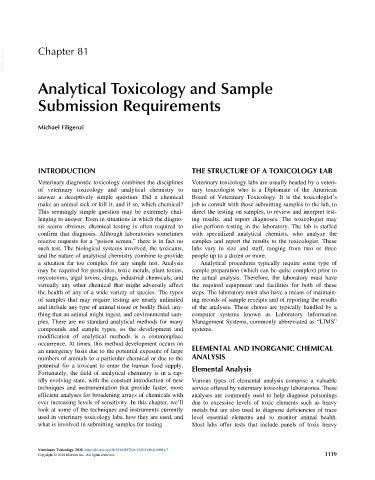Page 1187 - Veterinary Toxicology, Basic and Clinical Principles, 3rd Edition
P. 1187
VetBooks.ir Chapter 81
Analytical Toxicology and Sample
Submission Requirements
Michael Filigenzi
INTRODUCTION THE STRUCTURE OF A TOXICOLOGY LAB
Veterinary diagnostic toxicology combines the disciplines Veterinary toxicology labs are usually headed by a veteri-
of veterinary toxicology and analytical chemistry to nary toxicologist who is a Diplomate of the American
answer a deceptively simple question: Did a chemical Board of Veterinary Toxicology. It is the toxicologist’s
make an animal sick or kill it, and if so, which chemical? job to consult with those submitting samples to the lab, to
This seemingly simple question may be extremely chal- direct the testing on samples, to review and interpret test-
lenging to answer. Even in situations in which the diagno- ing results, and report diagnoses. The toxicologist may
sis seems obvious, chemical testing is often required to also perform testing in the laboratory. The lab is staffed
confirm that diagnosis. Although laboratories sometimes with specialized analytical chemists, who analyze the
receive requests for a “poison screen,” there is in fact no samples and report the results to the toxicologist. These
such test. The biological systems involved, the toxicants, labs vary in size and staff, ranging from two or three
and the nature of analytical chemistry combine to provide people up to a dozen or more.
a situation far too complex for any single test. Analysis Analytical procedures typically require some type of
may be required for pesticides, toxic metals, plant toxins, sample preparation (which can be quite complex) prior to
mycotoxins, algal toxins, drugs, industrial chemicals, and the actual analysis. Therefore, the laboratory must have
virtually any other chemical that might adversely affect the required equipment and facilities for both of these
the health of any of a wide variety of species. The types steps. The laboratory must also have a means of maintain-
of samples that may require testing are nearly unlimited ing records of sample receipts and of reporting the results
and include any type of animal tissue or bodily fluid, any- of the analyses. These chores are typically handled by a
thing that an animal might ingest, and environmental sam- computer systems known as Laboratory Information
ples. There are no standard analytical methods for many Management Systems, commonly abbreviated as “LIMS”
compounds and sample types, so the development and systems.
modification of analytical methods is a commonplace
occurrence. At times, this method development occurs on ELEMENTAL AND INORGANIC CHEMICAL
an emergency basis due to the potential exposure of large
numbers of animals to a particular chemical or due to the ANALYSIS
potential for a toxicant to enter the human food supply. Elemental Analysis
Fortunately, the field of analytical chemistry is in a rap-
idly evolving state, with the constant introduction of new Various types of elemental analysis comprise a valuable
techniques and instrumentation that provide faster, more service offered by veterinary toxicology laboratories. These
efficient analyses for broadening arrays of chemicals with analyses are commonly used to help diagnose poisonings
ever increasing levels of sensitivity. In this chapter, we’ll due to excessive levels of toxic elements such as heavy
look at some of the techniques and instruments currently metals but are also used to diagnose deficiencies of trace
used in veterinary toxicology labs, how they are used, and level essential elements and to monitor animal health.
what is involved in submitting samples for testing. Most labs offer tests that include panels of toxic heavy
Veterinary Toxicology. DOI: http://dx.doi.org/10.1016/B978-0-12-811410-0.00081-7
Copyright © 2018 Elsevier Inc. All rights reserved. 1119

